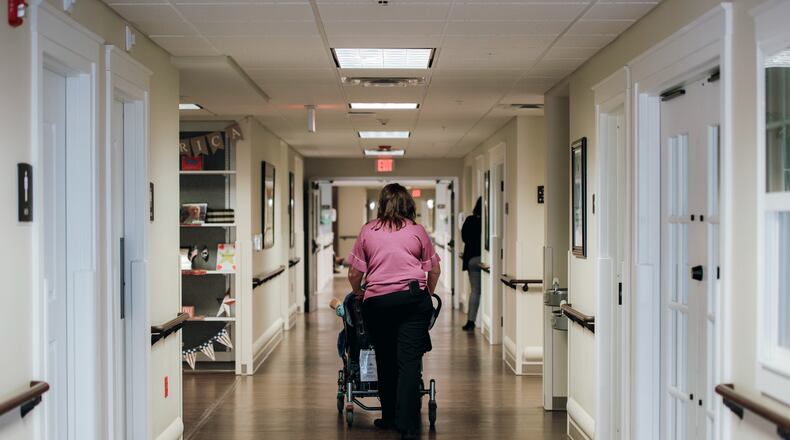Even if CMS under the new administration tries to roll back the staffing mandates, it will be a lengthy process, said Pete Van Runkle, executive director of the Ohio Health Care Association.
“They can’t just wave a wand and say it goes away,” Van Runkle said.
While it’s not unlikely that CMS under a Republican administration would be interested in trying to undo the staffing mandate, it will take time, Van Runkle said. CMS will have to go through the same process it went through when it passed the staffing mandate under President Joe Biden’s administration.
“They would have to go back through the notice and comment rulemaking process,” Van Runkle said.
The minimum staffing standards were first proposed in mid-2023 and didn’t get finalized until April 2024, he said, so it would take several months to do that process again.
Other measures while mandate is phased in
From lawsuits to lobbying lawmakers, the American Health Care Association (AHCA) is pursuing other means to pull back the minimum staffing requirements from CMS.
“AHCA is very confident that they will prevail in that litigation because CMS has gone beyond their statutory authority given by Congress by passing the staffing mandate that they did,” Van Runkle said.
Lawmakers have also pursued legislative means in order to prevent the full rollout of the staffing mandates, he said. Those didn’t make it out of the last congressional session, but with a Republican-led Congress and Trump in the White House, AHCA is confident that legislation will pass, Van Runkle said.
The minimum staffing requirements are not in full effect yet as a transition is meant to take place over the next few years. The first phase became effective on Aug. 8, which included nursing homes conducting enhanced facility-wide staffing assessments.
For urban nursing facilities, the second phase of the staffing mandate would take effect two years after publication, so by May 2026. For rural facilities, the second phase will be effective three years after publication of the rule by May 2027, according to KFF, a health policy, research and news organization.
The second phase would include the implementation of some of the staffing requirements, including the requirement for nursing facilities to have a registered nurse on duty at all times, as well as to have at least 3.48 hours of direct care per resident day.
The third and final phase would implement additional requirements for the number of hours nursing staff and aides would be required to spend with residents, but that phase wouldn’t get implemented until May 2027 for urban facilities and May 2029 for rural facilities.
Low staffing tied to ‘failure to respond’ complaints
Most nursing home complaints in the area are related to staffing issues, according to the local Ombudsman Office, which investigates complaints about government agencies and services in nine area counties, including long-term care facilities.
Ohio requires skilled nursing homes to provide at least 2.5 hours of direct care and services to each resident per day, according to the Ohio Administrative Code.
The federal recommendation, though not a requirement, is 4.1 hours of direct care per resident per day, said Chip Wilkins, a local certified ombudsman specialist.
“We believe anything below the 4.1 hours is going to have an adverse effect on resident care,” Wilkins said.
The top complaint the Ombudsman Office receives from nursing home residents are “failure to respond to request for assistance” complaints, he said.
Those types of complaints could include when residents use a call light to request help from staff, such as for medical concerns, bathroom assistance, room amenities, mobility or repositioning issues and so on.
“A call light may take 30 minutes to be answered in one facility. It may take an hour at another facility,” Wilkins said.
The response times are directly related to the staffing at each facility, he said.
“Traditionally, we have found that the facilities that have staffing at or near the 2.5 hours of direct care per day, they are the ones that have the most complaints to our office because of the fact that, with the staffing levels at the 2.5 hours per day, facilities are unable to timely respond to requests for assistance,” Wilkins said.
Calls for assistance can have medical implications, such as if a resident starts to have chest pains and calls for help, but does not receive a response quickly enough.
“You’re going to end up coming into a room with a resident that’s passed away,” Wilkins said.
The Ombudsman Office has had complaints from nursing home residents who have had to wait in their bathrooms for hours because someone was not responding, he said.
“When there’s a delay in responding, that’s always a direct result of staffing levels being substandard. It really is the residents that suffer,” Wilkins said.
Nursing homes are required to post staff-to-patient ratios in a conspicuous area each day, Wilkins said.
Challenges with getting nursing homes staffed include not only costs, but also the availability of staff to hire.
Some facilities may be forced to close, Van Runkle said.
It’s unclear if the nursing home market in the Dayton region would be able to accomodate displaced residents from a facility that closes. With a growing population of older Americans who may need to live at a nursing home in the future, the trend tends to lead toward needing more beds rather than less, Wilkins said.
HOW TO CHECK
For those who want to find compare nursing homes, the Ohio Department of Aging offers a nursing home navigator online at aging.ohio.gov. Medicare also has a comparison tool available at medicare.gov/care-compare.
About the Author


